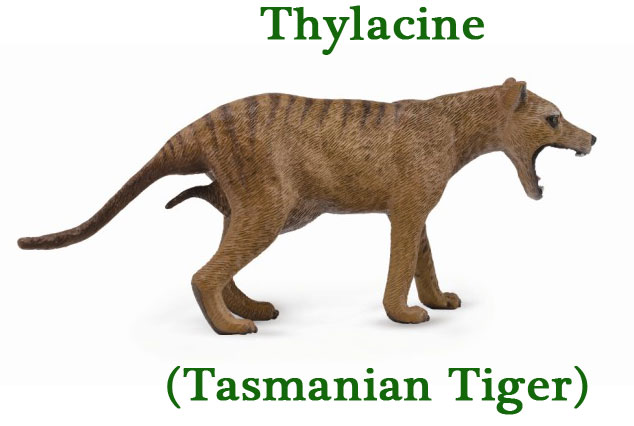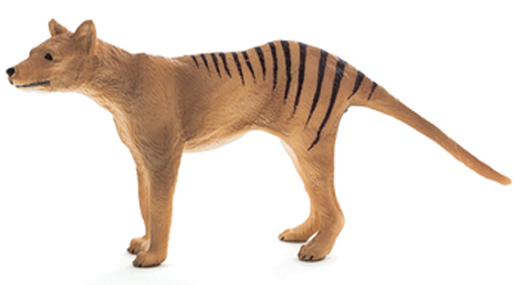National Thylacine Day
Today, marks the 81st anniversary of the death of the last known Thylacine. The animal, nick-named Benjamin, died this day (7th September 1936), at Beaumaris Zoo (Hobart, Tasmania). The Thylacine (sometimes referred to as the Tasmanian Tiger, probably due to its prominent stripes), was the largest carnivorous marsupial of the Holocene Epoch. It was the last member of the once diverse and numerous Thylacinidae family, which once ranged over Australia and New Guinea.
Thylacine Models
Over the last few years, Everything Dinosaur has been able to add a couple of Thylacine models to its extensive range of prehistoric and extinct animal replicas. In 2016, CollectA added a female Thylacine model to its hugely popular CollectA Prehistoric Life model range. The model can be clearly identified as a female because of the very obvious pouch. The CollectA Thylacine model measures a fraction under twelve centimetres in length and the model’s head is some five centimetres off the ground.
The CollectA Thylacine Model
To view the CollectA range of models: CollectA Prehistoric Life Models.
The distended pouch suggests that this particular Thylacine is carrying young. This impressive, hand-painted model has received excellent reviews. For example, a recent 5-star FEEFO review stated that this CollectA model was:
“Very high-quality product.”
Thylacinus cynocephalus
Aboriginal rock art records Thylacines and numerous fossil sites are known from Western Australia. The Tasmanian Tiger ranged extensively over Australia and Tasmania, a mummified carcass was discovered in the famous Nullarbor Cave in 1969 by a field team from the Western Australian Museum.
Mojo Fun also has a Thylacine replica in its model range (Mojo Fun Prehistoric and Extinct Animals), this replica is approximately the same size as the CollectA model and just like the CollectA replica, it is hand-painted. Everything Dinosaur added this model range to its portfolio as part of plans to expand the company’s extensive model range.
The Mojo Fun Thylacine Model
The Mojo Fun Thylacine has also received excellent reviews from collectors, such as this 5-star FEEFO rating – “Well-made model, exactly as presented on your web site.”
View Mojo Fun models: Mojo Fun Prehistoric and Extinct Figures.
Quality Thylacine Models
Such is the quality of these two figures, that we have supplied numerous scientists, academics and museum staff with these models.
To view the range of prehistoric and extinct animal replicas available from Everything Dinosaur: The Models Available from Everything Dinosaur.
September 7th is “National Threatened Species Day” in Australia. This day is dedicated to acknowledging the efforts of those hard-working conservationists who strive to protect Australia’s flora and fauna. It is also a day for remembering the Thylacine, our species Homo sapiens, was responsible for the extinction of this beautiful and little understood predator.
There have been several credible sightings in recent years, and prompted by some plausible eye-witness accounts, scientists from James Cook University have set up camera traps in a remote part of northern Queensland in a bid to capture irrefutable evidence that this enigmatic marsupial still exists. Everything Dinosaur featured the plans to hunt for Thylacines in a blog article published in the spring: Hunting for Tasmanian Tigers.
The idea that a handful of “Tigers” might be still in the outback, is a very intriguing idea, however, scientists at the University of California, Berkeley, put together a mathematical model to assess the probability of the Thylacine still existing. Having assessed all the sightings and other evidence, the most optimistic view is that the Thylacine might have persisted to around 1950 but the chances of finding a Thylacine alive today are extremely remote. How remote? About 1 in 1.6 trillion according to the mathematicians.
Visit the award-winning Everything Dinosaur website: Everything Dinosaur.








RE: “Chances of finding a thylacine alive today is extremely remote”
It may interest the scientists at UCB :
The Tasmanian Devil, a smaller carnivorous marsupial,( famous for its fearsome call and aggressive stance) recently developed a
transmissible facial tumor cancerous disease. It was mostly transmitted between individuals whilst competing for the same kill, thus
biting each other.
Zoologists were alarmed to arrive at an estimate that over 80% of individuals in the wild were infected and that the condition was ultimately fatal. With the risk of rapid extinction of another important carnivorous marsupial, urgent action was undertaken to separate
genetically screened and uninfected individuals as a back-up captive breeding program. This program was successful in approaching
the objective of breeding an immune group which could be released to the wild.
In the process of planning release, however, the research team discovered a yet unknown population of devils in the remote south west
Tasmanian rain forest which appeared to be an isolated and immune group, never recorded since white colonisation.
My point: In the process of protecting this marsupial, another unknown group was discovered within the isolated Tasmanian wilderness.
this group was immune to facial cancer and unknown until extensive examination of their habitat was mounted.
We are all so pleased that the devil is out of trouble. The circumstances of the Thylacine ‘extinction’ ? During the late 19th century and ending in the 1920s, a Tasmanian state government bounty for Thylacine extermination led to an estimated 2000 Thylacines having been killed by Tasmanian settlers in the vicinity of Tasmanian settlements.
The last Thylacine in captivity died at Beaumauris Zoo, Hobart, Tasmania in 1936. Tasmanians and Australians generally felt much regret over the human role in such an outcome. After WWII, an expedition was mounted to see if any thylacine groups had survived in the ‘wild”. None were found. Trapping also rendered no result. As a result, the scientific establishment at the time decided that
the death of Thylacine “Ben” at Hobart in 1936 was to be deemed the “extinction event” and that if no further Thylacines were discovered within the next 50 years, the Thylacine was to be officially announced as extinct in 1986.
It is also worthy of noting that during the 1890s, the Thylacine Preservation Society released a group of Thylacines onto the Australian
mainland in the region of remote Victoria (the closest mainland region to Tasmania) in an effort to save the animal from the Tasmanian
state Thylacine bounty. Ironically, the Thylacine is featured on the Tasmanian state cote of arms.
In addition, political pressure developed around the possibility that rediscovering the Thylacine would subject Tasmania to federal calls
for sanctuaries, a measure which limited Tasmanians in the exploitation of their natural resources.
They exist and I swear to this. Not only native to the areas known to be.